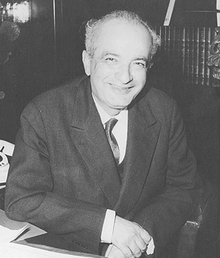Noureddin Alamouti
Noureddin Alamouti (Persian: نورالدین الموتی) was an Iranian judge and politician. He served as the justice minister under the cabinet of Ali Amini, during which he was noted for forming a powerful anti-corruption division[1] that led to "the last serious attempt to realize the rule of law" in Pahlavi dynasty.[2]
Noureddin Alamouti | |
|---|---|
 | |
| Minister of Justice | |
| In office 5 May 1961 – 19 July 1962 | |
| Prime Minister | Ali Amini |
| Personal details | |
| Born | 1901 Varak, Qazvin, Iran |
| Died | 1965 (aged 63–64) Tehran, Iran |
| Nationality | Iranian |
| Political party | Democrat Party (1947–48) Tudeh Party (1941–47) Democrat Party (1919) |
Early life
He came from the rural district of Alamut. In 1919, he joined the Democrat Party and was imprisoned in 1923 for "agitating among the local peasantry". Alamouti was employed at the justice ministry during rule of Reza Shah.[3]
Political career
One of the members of the "group of fifty-three", he was jailed in 1938. He later joined the Tudeh Party of Iran immediately after its establishment in 1941 and was elected to its provisional central committee.[3] At the party's first congress in 1944, he was elected to the central committee[4] and served as the party's general-secretary, a position he shared with Mohammad Bahrami and Iraj Eskandari.[5]
He was listed by Tudeh for a Tehran seat in Iranian legislative election, 1943–1944,[6] but was defeated. In 1946, Alamouti was excluded from the central committee because he was "not [a] full-fledged Marxist".[7] He left the party in 1947 and joined the entourage of Ahmad Qavam.[1] Alamouti was allegedly detested by Mohammad Reza Shah.[8]
Ministry
Alamouti was appointed as the justice minister in 1961 and served in the capacity until July 1962. He launched a campaign to fight corruption and abuse of power among the ruling elite that led to jailing several high-ranking officials, including police chief general Alavi-Moghadam (charged with bribetaking), military prosecutor Hossein Azmoudeh and former plan and budget head Abolhassan Ebtehaj (charged with $69 million embezzlement).[2] He appointed Ahmad Sadr Haj Seyyed Javadi as prosecutor of Tehran, who joined him in the anti-corruption legal activism. Among the military officers prosecuted during the period, were general Kia, Zarghami, Daftari, Khazaei and Nevissi.[2] After he left office following resignation of Ali Amini, all detainees were released and the charges were dropped, however the effects of the activism were not forgotten.[2] Three years later, some 100 judges were dismissed.[2]
References
- Abrahamian, Ervand (1982). Iran Between Two Revolutions. Princeton University Press. pp. 423. ISBN 0-691-10134-5.
- Enayat, Hadi (2013). Law, State, and Society in Modern Iran: Constitutionalism, Autocracy, and Legal Reform, 1906–1941. Springer. ISBN 9781137282026.
- Abrahamian, Ervand (1982). Iran Between Two Revolutions. Princeton University Press. pp. 287. ISBN 0-691-10134-5.
- Abrahamian, Ervand (1982). Iran Between Two Revolutions. Princeton University Press. pp. 295. ISBN 0-691-10134-5.
- Abrahamian, Ervand (1982). Iran Between Two Revolutions. Princeton University Press. pp. 297. ISBN 0-691-10134-5.
- Ladjevardi, Habib (1985). Labor Unions and Autocracy in Iran. Syracuse University Press. p. 44. ISBN 978-0-8156-2343-4.
- Abrahamian, Ervand (1982). Iran Between Two Revolutions. Princeton University Press. pp. 306. ISBN 0-691-10134-5.
- P. Avery; William Bayne Fisher; G. R. G. Hambly; C. Melville, eds. (1990). The Cambridge History of Iran. 7. Cambridge University Press. p. 273. ISBN 9780521200950.
| Party political offices | ||
|---|---|---|
| Preceded by Soleiman Eskandari as Chairman |
Co-General-Secretary of the Tudeh Party of Iran 1944–1947 Served alongside: Mohammad Bahrami and Iraj Eskandari |
Succeeded by Reza Radmanesh as First-Secretary |